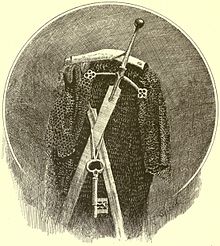- Claymore
-
- This article is about the two-handed sword. The term "claymore" is sometimes also applied to the Scottish broadsword of the 17th and 18th centuries. For yet other uses, see Claymore (disambiguation).
Claymore 
Claymore replicaType Sword Place of origin Scotland Service history In service ca. 1400 - 1700 Used by Highlanders Specifications Weight ~2.2–2.8 kg (4.9–6.2 lb)[citation needed] Length ~120–140 cm (47–55 in)[citation needed] Blade length ~100–115 cm (39–45 in)[citation needed] Blade type Double-edged Hilt type Two-handed cruciform, with pommel  Engraving of a claymore and armour at Dunvegan Castle (from Footsteps of Dr. Johnson, 1890).
Engraving of a claymore and armour at Dunvegan Castle (from Footsteps of Dr. Johnson, 1890).
The term claymore (pronounced /ˈkleɪmɔər/, from Scottish Gaelic claidheamh mòr, "great sword"[1]) refers to the Scottish variant of the late medieval longsword, two-handed swords with a cross hilt, of which the guards were in use during the 15th and 16th centuries.
Contents
Terminology
The term claymore is an anglicisation of the Gaelic claidheamh mòr "great sword", first attested in 1772 (as Cly-more) with the gloss "great two-handed sword".[2] The sense "basket-hilted broadsword" is contemporaneous, attested in 1773 as "The broad-sword now used [...] called the Glaymore, (i.e. the great sword)."[3] OED observes that the latter usage is "inexact, but very common". The 1911 Encyclopædia Britannica likewise judged that the term is "wrongly" applied to the basket-hilted sword.
Authors arguing that the basket-hilted sword is "incorrectly" called claymore have been known to suggest that claybeg (from a purported Gaelic claidheamh beag "small sword") should be used instead.[4]
But it should be noted that this doesn't parallel Scottish Gaelic usage: According to the Gaelic Dictionary by R. A. Armstrong (1825), claidheamh mòr translates to "broadsword", and claidheamh dà làimh to "two-handed sword", while claidheamh beag is given as a translation of Bilbo.[5]
The term "claymore" became part of vocabulary of the Victorian era sentimental or Romanticist "retro-Jacobite" literature and poetry such as the Skye Boat Song (1870).
Other contemporary Gaelic descriptives of swords include claidheamh cuil or back sword, referring to a single-edged or edge-and-a-quarter sword with a flat "spine" [not one worn on the back, a common misinterpretation], the claidheamh crom or crooked sword, which could describe either a typical saber style blade (such as that worn by Archibald Campbell, 1st Duke of Argyll, in the painting by Medina) or a scimitar style blade known as a "turcael" ("turkish" blade) such as that brandished by Alasdair Mor, the Champion of Clan Grant, in the c. 1715 portrait by Waitt, or the claidheamh caol or narrow sword, usually describing a rapier or small-sword.[citation needed]
It should be noted that the term claybeg, purportedly from Scots Gaelic claidheamh beg meaning "little sword" is not seen in clan-era Gaelic song or poetry, 'Dwelly's' [ibid.], or other authorities, and seems to be a fairly recent invention.)[citation needed]
Two-handed (Highland) claymore
The two-handed claymore was a large sword used in the late Medieval and early modern periods. It was used in the constant clan warfare and border fights with the English from circa 1400 to 1700.[6] The last known battle in which it is considered to have been used in a significant number was the Battle of Killiecrankie in 1689.[citation needed] It was somewhat smaller than other two-handed swords of the era. The two-handed claymore seems to be an offshoot of Early Scottish medieval longswords which had developed a distinctive style of a cross-hilt with downsloping arms that ended in spatulate swellings. The spatulate swellings were frequently made in a quatrefoil design.
The average claymore ran about 140 cm (55 in) in overall length, with a 33 cm (13 in) grip, 107 cm (42 in) blade, and a weight of approximately 5.5 lb (2.5 kg).[citation needed]
Fairly uniform in style, the sword was set with a wheel pommel often capped by a crescent-shaped nut and a guard with straight, down-sloping arms ending in quatrefoils and langets running down the center of the blade from the guard.[citation needed] Another common style of two-handed claymore (though lesser known today) was the "clamshell hilted" claymore. It had a crossguard that consisted of two downward-curving arms and two large, round, concave plates that protected the foregrip. It was so named because the round guards resembled an open clam.[citation needed]
See also
- Historical fencing in Scotland
References
- ^ "claymore". Oxford English Dictionary, 2nd ed., 1989. [1] (subscription required)
- ^ Thomas Pennant, A map of Scotland, the Hebrides, and part of England, cited after OED. See also Alexander Robert Ulysses Lockmore (1778). Annual Register Vol. 23. London.[clarification needed]
- ^ James Boswell, The journal of a tour to the Hebrides, with Samuel Johnson, cited after OED.
- ^ so Nick Evangelista, The encyclopedia of the sword, 1995, ISBN 9780313278969, p. 113. The suggestion appears as early as 1835, in a letter to the editor of The United service magazine p. 109: "... the claybeg or Andrew Ferrara, now worn by the officers and sergeants of the Highland corps, and which has usurped the venerable name of the ancient Scottish weapon".
- ^ A Gaelic Dictionary, p. 120. see also Wagner, Paul; Christopher Thompson (2005). "The words "claymore" and "broadsword"". SPADA (Highland Village, Texas: The Chivalry Bookshelf) 2: 111–117.. Dwelly's Illustrated Gaelic to English Dictionary (Gairm Publications, Glasgow, 1988, p. 202); 'Culloden - The Swords and the Sorrows (The National Trust for Scotland, Glasgow, 1996).
- ^ swords and sabers harvey J S withers
- Dwelly's Illustrated Gaelic to English Dictionary (Gairm Publications, Glasgow, 1988, p. 202)
 Chisholm, Hugh, ed (1911). "Claymore". Encyclopædia Britannica (11th ed.). Cambridge University Press.
Chisholm, Hugh, ed (1911). "Claymore". Encyclopædia Britannica (11th ed.). Cambridge University Press.
External links
Categories:- Medieval European swords
- Early Modern European swords
- Military history of Scotland
Wikimedia Foundation. 2010.
